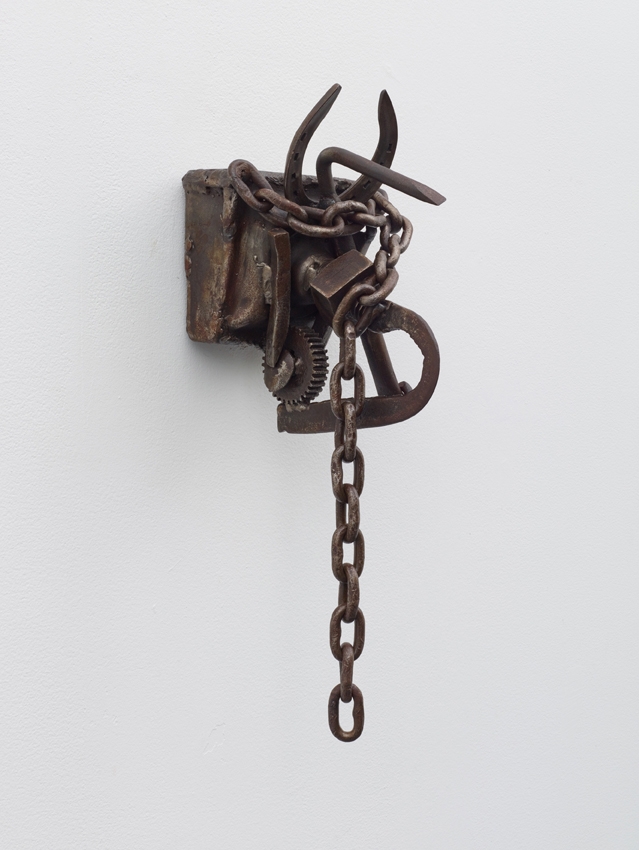Los Angeles, 1963: amid nationwide debates for an abstract ‘art for art’s sake’, and a more figurative art that was perceived as being more political, and therefore more relevant to the ongoing Civil Rights Movement, sculptor Melvin Edwards chose… both. The welded steel works he has created over the following 50 years have hovered between a stern modernist formalism and suggestive biomorphic shapes, while all the while remaining resolutely what they are: masses of chains, railroad spikes, gears, hammers and axes. It’s just metal, but it’s also the gruff, raw materials of industry, labour and slavery.
Then There Here and Now – Circle Today (1970/2014) comprises in part several dozen lines of barbed wire that swoop down from the ceiling, attached at the wall to form a circle; the sharp lines still manage to create a soothing shape akin to a seashell or flowing hair. His Lynch Fragments series, begun in 1963 and still going, are dense assemblages of industrial scraps, all roughly head-size and hung at head height on the wall, as if some sort of mounted trophy. Amandla (1981) looks like the head of a bull or horned devil-like creature from a distance, though up close it falls apart into its constituent parts of a horseshoe and chain shot through with a long, cruelly bent spike. Three nails curve up like small hands to crown Night Talk (1986), a clamp jutting forward like a chin or some sort of animal tusk. These are haunted scraps, where each bit hovers in and out of being a nut or an eye, a bolt or a tooth, the series a parade of mute, mangled faces.
This exhibition is, in part, a historical corrective: Edwards was the first African-American sculptor to have a solo exhibition at the Whitney, yet this is his first solo exhibition in the UK, and only his second in Europe. All of which explains the museological feel to the selection, encompassing several representative bodies of work, spanning 1964–94. The Rocker series is a set of small crescent-shaped constructions on plinths, as if junkyard models for cradles or rocking chairs. The gentle angle of the silver ‘rocker’ Untitled (c. 1971) is topped with the mesh of a steel walkway, but it’s the patterned shadow underneath that exerts the main pull. Untitled Rocker (c. 1990) is an upside-down tilted arc of rusted steel, though its chain-lined lower lip is slightly swollen and bent upwards, giving the metal mass a sudden, unexpected fleshy tenderness. With the wider international recognition that Edwards is finally now receiving, his work also offers another kind of corrective – this is Lygia Clark gone to the American South, pinning a specificity and conscience to any lofty modernist ideals. Renewed interest in Edwards’s work is timely, given the parallels between the struggles of the 1960s and the current unrest in the US, and while his approach hasn’t changed, neither have the problems he sought to address. We don’t need to be told that these are ‘about’ race, violence or struggle, as they markedly and openly carry that weight with them.
This article was first published in the March 2015 issue.
